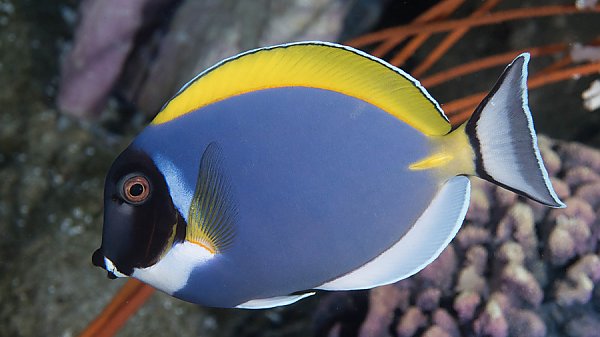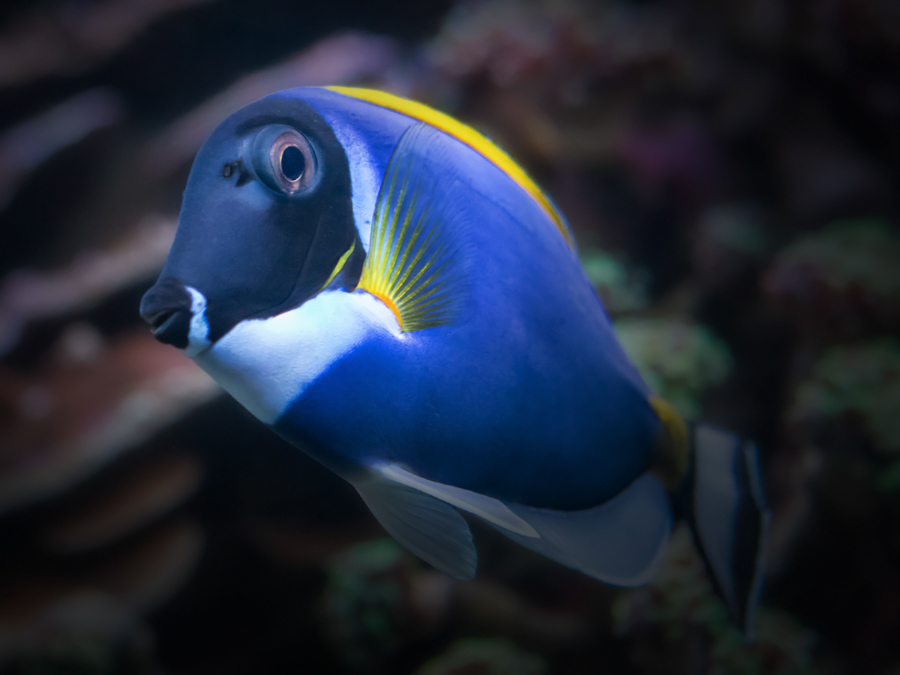Powder Blue Tang
Acanthurus leucosternon
The powder blue tang is a coral reef-dwelling surgeonfish with a laterally compressed oval body and vivid mostly blue coloring that makes it popular in the marine aquarium industry. It is typically a solitary and territorial fish and is an herbivore feeding mainly on algae.

Credit: Ken Kurtis/Aquarium of the Pacific

Credit: Robin Riggs/Aquarium of the Pacific
SPECIES IN DETAIL
Powder Blue Tang
Acanthurus leucosternon
CONSERVATION STATUS: Least concern
CLIMATE CHANGE:
At the Aquarium
The Aquarium has powder blue tangs in the Tropical Reef Habitat, Soft Coral Garden, Live Coral, and Tropical Pacific Preview exhibits in the Tropical Pacific Gallery and in Shark Lagoon’s large touch pool.
Geographic Distribution
Powder blue tangs are found throughout the Indian Ocean, from eastern Africa to the Andaman Sea, southwest Indonesia, and Christmas Island, into the western Pacific Ocean to Bali, Indonesia.
Habitat
Powder blue tangs live in clear shallow waters surrounding inshore coral reefs, specifically preferring reef flats and upper seaward slopes.
Physical Characteristics
The powder blue tang has an oval-shaped laterally compressed body. Its body color is vivid blue with a black head and a broad white band from pectoral fin to throat. It has a vivid yellow coloration on its dorsal fin and at the base of the caudal fin. It has white pelvic and anal fins and a crescent-shaped caudal fin. It has a small, pointed, beak-like mouth with tiny sharp teeth. It has an erected spine on each side of the caudal peduncle base.
Size
These fish have an average length of 7.5 to 9 inches (19 to 23 centimeters) and a maximum length of 21 inches (54 centimeters).
Diet
This species grazes on benthic algae, either singly or in large feeding groups.
Reproduction
Powder blue tangs practice monogamous (pair) spawning.
Behavior
This fish grazes singly or in large feeding groups. When food isn’t plentiful, it may become aggressive to other fish invading its territory. It will feed in groups if food is plentiful.
Adaptation
The shape of its beak-like mouth is useful for accessing algae in small crevices.
Longevity
In the wild powder blue tangs typically live for about five years. They can live up to ten years in an aquarium setting.
Conservation
The powder blue tang is listed as a species of Least Concern by the International Union for Conservation of Nature.
SPECIES IN DETAIL | Print full entry
Powder Blue Tang
Acanthurus leucosternon
CONSERVATION STATUS: Least concern
CLIMATE CHANGE:
The Aquarium has powder blue tangs in the Tropical Reef Habitat, Soft Coral Garden, Live Coral, and Tropical Pacific Preview exhibits in the Tropical Pacific Gallery and in Shark Lagoon’s large touch pool.
Powder blue tangs are found throughout the Indian Ocean, from eastern Africa to the Andaman Sea, southwest Indonesia, and Christmas Island, into the western Pacific Ocean to Bali, Indonesia.
Powder blue tangs live in clear shallow waters surrounding inshore coral reefs, specifically preferring reef flats and upper seaward slopes.
The powder blue tang has an oval-shaped laterally compressed body. Its body color is vivid blue with a black head and a broad white band from pectoral fin to throat. It has a vivid yellow coloration on its dorsal fin and at the base of the caudal fin. It has white pelvic and anal fins and a crescent-shaped caudal fin. It has a small, pointed, beak-like mouth with tiny sharp teeth. It has an erected spine on each side of the caudal peduncle base.
These fish have an average length of 7.5 to 9 inches (19 to 23 centimeters) and a maximum length of 21 inches (54 centimeters).
This species grazes on benthic algae, either singly or in large feeding groups.
Powder blue tangs practice monogamous (pair) spawning.
This fish grazes singly or in large feeding groups. When food isn’t plentiful, it may become aggressive to other fish invading its territory. It will feed in groups if food is plentiful.
The shape of its beak-like mouth is useful for accessing algae in small crevices.
In the wild powder blue tangs typically live for about five years. They can live up to ten years in an aquarium setting.
The powder blue tang is listed as a species of Least Concern by the International Union for Conservation of Nature.

